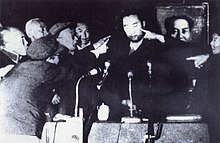
Back Kampf- und Kritiksitzung German Sesión de lucha Spanish گردهمایی محکومسازی Persian Kamppailuistunto Finnish Séance de lutte French Sesi perjuangan ID Sessione di lotta Italian Strijdbijeenkomst Dutch Kampsesjon NB Sessão de luta Portuguese

| Struggle session | |||||||||||
|---|---|---|---|---|---|---|---|---|---|---|---|
 10th Panchen Lama of Tibet during a struggle session, 1964 | |||||||||||
| Chinese name | |||||||||||
| Simplified Chinese | 批斗大会 | ||||||||||
| Traditional Chinese | 批鬥大會 | ||||||||||
| |||||||||||
| Tibetan name | |||||||||||
| Tibetan | འཐབ་འཛིང | ||||||||||
| |||||||||||
Struggle sessions (Chinese: 批斗大会; pinyin: pīdòu dàhuì), or denunciation rallies or struggle meetings,[3] were violent public spectacles in Maoist China where people accused of being "class enemies" were publicly humiliated, accused, beaten and tortured, sometimes to death, often by people with whom they were close.[4][5][6][3] These public rallies were most popular in the mass campaigns immediately before and after the establishment of the People's Republic of China, and peaked during the Cultural Revolution (1966–1976), when they were used to instill a crusading spirit among crowds to promote Maoist thought reform.[4][5][7][8]
Struggle sessions were usually conducted at the workplace, classrooms and auditoriums, where "students were pitted against their teachers, friends and spouses were pressured to betray one another, [and] children were manipulated into exposing their parents", causing a breakdown in interpersonal relationships and social trust.[3][9][10] Staging, scripts and agitators were prearranged by the Maoists to incite crowd support.[6][9][10]
In particular, the denunciation of prominent "class enemies" was often conducted in public squares and marked by large crowds of people who surrounded the kneeling victim, raised their fists, and shouted accusations of misdeeds.[6][9][10][11] Specific methods of abuse included hair shaving (阴阳头), dunce caps, "jetting" (喷气式) (similar to strappado), and verbal and physical attacks.[6][9]
- ^ "Liu Shaoqi (1898-1969)". Chinese University of Hong Kong. Archived from the original on 2018-06-04.
- ^ Ramzy, Austin (2016-05-14). "China's Cultural Revolution, Explained". The New York Times. Archived from the original on 2024-01-14.
- ^ a b c Lu, Xing (2004). "Denunciation rallies". Rhetoric of the Chinese Cultural Revolution: The Impact on Chinese Thought, Culture, and Communication. pp. 140–141.
- ^ a b Song, Yongyi (August 25, 2011). "Chronology of Mass Killings during the Chinese Cultural Revolution (1966–1976)". Sciences Po. Archived from the original on 2024-01-14. Retrieved December 27, 2019.
- ^ a b Wang, Youqin (2001). "Student Attacks Against Teachers: The Revolution of 1966" (PDF). The University of Chicago. Archived (PDF) from the original on 2020-04-17.
- ^ a b c d Sullivan, Lawrence R. (2011). "Struggle sessions". Historical Dictionary of the Chinese Communist Party. p. 390.
- ^ Meeting, Association for Asian Studies (1990-01-01). Violence in China: Essays in Culture and Counterculture. SUNY Press. ISBN 978-0-7914-0113-2. Archived from the original on 2023-06-15. Retrieved 2021-12-18.
- ^ Fang, Jucheng; Jiang, Guinong. "第九章 颠倒乾坤的"文化大革命"" [Chapter 9 The "Cultural Revolution" that turned everything upside down]. People's Net (in Chinese). Archived from the original on 2007-02-21. Retrieved 2021-04-18.
- ^ a b c d Wang, Youqin. "文革"斗争会"(上)" ["Struggle sessions" in the Cultural Revolution (Part 1)] (PDF). Leaders (in Chinese): 128–143. Archived (PDF) from the original on 2022-10-13 – via The University of Chicago.
- ^ a b c Wang, Youqin. "文革"斗争会"(下)" ["Struggle sessions" in the Cultural Revolution (Part 2)] (PDF). Leaders (in Chinese): 110–127. Archived (PDF) from the original on 2023-05-05 – via The University of Chicago.
- ^ Lipman, Jonathan Neaman; Harrell, Stevan (1990). Violence in China: Essays in Culture and Counterculture. SUNY Press. pp. 154–157. ISBN 9780791401156. OCLC 18950000.